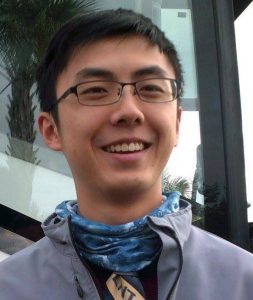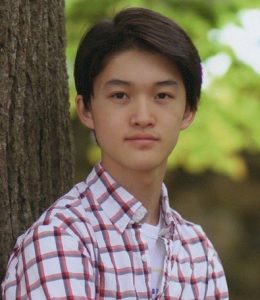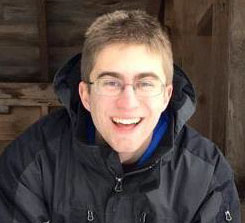From improving the performance of solar cells to genetically engineering yeast to make biofuels, eight undergraduates at Princeton University engaged in exciting energy- and environment-related research projects this past summer through the University’s Andlinger Center for Energy and the Environment. The students, who worked for eight weeks under the guidance of Andlinger Center faculty members, received funding for their projects through the Peter B. Lewis Fund for Student Innovation in Energy and the Environment and the Dede T. Bartlett P03 Fund for Student Research in Energy and the Environment.
Below are brief profiles on each of the participating students, their projects, and the lessons they took away from their internship.
Sherry Bai ’19
 Project Title: Investigating the Impact of Doping on Organic Solar Cells
Project Title: Investigating the Impact of Doping on Organic Solar Cells
Describe your project.
“This project involved the introduction of small amounts of dopants in organic solar cells and OLEDs (organic LEDS) in order to compensate for charged defects in the organic materials. (Organic means the molecules contain carbon.) We then examined the effects of doping on the electrical and optical properties of these devices. Dopants are substances introduced into semiconductor materials in very small amounts to change their optical and electrical properties.”
What is the practical application of your project?
“Organic semiconductor devices, such as solar cells and OLEDS, are of particular practical interest because production costs are significantly lower than those of inorganic semiconductor devices. Organic materials are relatively inexpensive, and large-scale production of organic devices is relatively simple. As a result, the organic solar cells involved in this research may contribute to lowering the cost of adopting solar power as an alternative energy source.”
Lessons learned.
“I found the differences between learning through courses and learning through research particularly striking. While courses can be enjoyable and fulfilling, the process of independently working on an experimental project and piecing together the results of that work is rewarding and enlightening in a fundamentally different way.”
Eric Chen ’19
 Project Title: Hall Effect Measurements for Energy-Relevant Semiconductors
Project Title: Hall Effect Measurements for Energy-Relevant Semiconductors
Describe your project.
“The project aimed to improve Hall effect voltage measurements in low-conductivity thin film materials by developing an automated measuring system. (Hall effect is a type of electrical phenomenon.) The system we developed connected power sources and sensors together to create a varying magnetic field with rotating neodymium magnets. We successfully created both the mechanical apparatus and computer code to run this experiment.”
What is the practical application of your project?
“Low-conductivity thin films have broad applications in solar cells, LEDs, and other large area electronic devices. As a result, verifying the fundamental characteristics by accurately measuring the Hall effect is a critical first step for developing these energy devices.”
Lessons learned.
“The most rewarding aspect of this summer was learning from everyone else around me. The research experience is a positively collaborative venture. Alone, I could never have the full picture of where to go next or what to do. But having guidance from others with a deep knowledge of the field helped me from the big picture (e.g., how to design the measurement apparatus) to the small picture (e.g., how best to format and present my data).”
Isabella Grabski ’18
 Project Title: Plasmon-Assisted Dissociation of Carbon Dioxide on Metallic Nanoparticles with Embedded Correlated Wavefunction Methods
Project Title: Plasmon-Assisted Dissociation of Carbon Dioxide on Metallic Nanoparticles with Embedded Correlated Wavefunction Methods
Describe your project:
“I computationally modeled the reverse water-gas shift reaction using methods based on quantum chemistry. This reaction is commonly used in industrial settings at high temperatures and pressures, which makes it very energetically expensive. By modeling this reaction, I aimed to study how a more environmentally friendly method of catalysis using light could be used instead.”
What is the practical application of your project?
“Ultimately, this process could be carried out in industrial settings with significantly less impact to the environment.”
Lessons learned.
“This project was my first long-term research experience with computational work. Prior to this, I’ve only worked in traditional wet lab environments, which I never enjoyed and always conflated with not liking research as a whole. Doing this project made me realize I actually do really enjoy research — it was just the typical lab environment that didn’t appeal to me. This was an immense help in me decide that I want to attend graduate school after Princeton.”
Theo Keeley-LeClaire ’18
 Project Title: Post-Transcriptional Control Using Optically Activated Proteins
Project Title: Post-Transcriptional Control Using Optically Activated Proteins
Describe your project.
“My research project consisted of investigating a novel method of controlling the alcohols (isobutanol) produced during the metabolism of sugars by yeast S. Cerivisiae. This method uses optically activated proteins that cluster when exposed to blue light in order to change the flux of metabolic intermediates between different pathways. In my research, these proteins were attached to enzymes involved in the production of isobutanol from pyruvate, a product of glucose metabolism. This was designed so the yeast would switch from the production of ethanol via normal fermentation to the production of isobutanol when exposed to blue light.”
What is the practical application of your project?
“My research focused on using yeast to produce isobutanol as a biofuel, which is practically much more useful than ethanol. Whereas ethanol can only be used in low percentages as a gasoline additive, isobutanol and other long-chain alcohols can be used in much higher percentages and may even be developed as a gasoline alternative. Furthermore, isobutanol releases less carbon dioxide per unit energy than ethanol. Developing a viable method of producing isobutanol would make biofuels a much more realistic and exciting alternative energy source.”
Lessons learned.
“Perhaps the most important lesson I drew from my project is that even ideas that don’t work out have value. While the method I investigated ended up giving inconclusive results and does not seem to be effective, I learned valuable laboratory skills throughout my research. The most rewarding aspect of my summer research was having the opportunity to work with a group of brilliant researchers and thinkers who challenged me to be thorough and inventive, which was a very valuable experience for me.”
Andy Liu ’19
 Project Title: Mitochondria Engineering in Yeast for the Production of Isobutanol
Project Title: Mitochondria Engineering in Yeast for the Production of Isobutanol
Describe your project.
“The purpose of my summer research project is to artificially enhance the capability of brewer’s yeast to produce isobutanol from glucose through genetic engineering. We manipulated the genetic expression of yeast by using plasmids and other vectors obtained from E. Coli to achieve this. The main focus of my project is on the effect of a protein called mitochondria pyruvate carrier (MPC).”
What is the practical application of your project?
“The production of isobutanol is important for the future applications of the biofuels industry. Biofuels present a low-carbon way of living and currently, the use of ethanol has its limitations due to its incompatibility to industrial infrastructure. In essence, isobutanol is a much better fuel.”
Lessons learned.
“I gained valuable insight into the routines of a researcher and interacting with graduate students on a personal/co-worker level led me to appreciate scientific research more. Meanwhile, the research experience also made me realize the importance of an interdisciplinary approach especially in engineering. In order to achieve a certain goal, engineers must be extraordinarily resourceful and insightful.”
Andrew Ma ’19
 Project Title: Enhancement of OLED Outcoupling Efficiency Using a Nanostructured Top Metal Electrode
Project Title: Enhancement of OLED Outcoupling Efficiency Using a Nanostructured Top Metal Electrode
Describe your project.
“Organic LEDs (OLEDs) are a promising possibility for general lighting. However, a major limitation on OLED efficiency is that photons (light particles) are trapped as surface waves rather than being emitted out of the OLED. In my summer research project, I worked on creating a nanoscale structure to reduce this inefficiency.”
What is the practical application of your project?
The OLEDs we worked on are designed to emit scattered light, so the natural practical application is towards energy-efficient general lighting.
Lessons learned.
“Besides the specific research area, I learned a lot about the research process as a whole. Research is very different from coursework as it’s a creative process, so there’s no fixed way to think about a problem. I really enjoyed doing hands-on work in the research lab. I’m definitely interested in doing more research in the future.”
 Jason Mulderrig ’18
Jason Mulderrig ’18
Project Title: Analysis of Helmholtz Resonance-Piezoelectric Energy Harvester via Wind Tunnel Tests
Describe your project.
“My summer research project investigated the feasibility of producing electricity in a soda-bottle-like container from an oscillating pressure column excited by typical wind conditions. The energy in the oscillating pressure column is transformed into electricity via a material inserted in the container called a piezoelectric.”
What is the practical application of your project?
“The practical applications of my research includes remote powering for small scale sensors and generating wind power in tight spaces such as on buildings in the urban environment.”
Lessons learned.
“One thing that stood out during my summer conducting research on this project was the amount of time and energy I spent on coding, particularly coding for the data analysis. It was more involved than I anticipated, but I learned a lot through that experience. The most rewarding part of my summer working on the research project was being able to focus exclusively on one project and guide that project from infancy to maturity in a relatively short period of time.”
Sam Smiddy ’17
 Project Title: Fluid-Driven Fractures and Backflow in a Multilayered Elastic Matrix
Project Title: Fluid-Driven Fractures and Backflow in a Multilayered Elastic Matrix
Describe your project.
“Motivated by the recent rise in hydraulic fracturing, this summer I researched how a fracturing fluid would flow into a gelatin matrix model that mimicked the natural faults in the Earth. It was a two-part study. First, we observed the dynamics when pressurized fluid is injected at a constant flow rate into the gelatin matrix that models the Earth’s bedrock and natural shale formations. Secondly, we studied the volume of fluid remaining in the matrix once the injection pressure is released and the fluid (often toxic wastewater) flows back.
What is the practical application of your project?
My research is most applicable to hydraulic fracturing, the primary method of natural gas collection. My research may lead to fine tuning the process, improving performance and efficiency, and lessoning the environmental footprint.
Lessons learned.
“Something that really stood out during my project was how much is totally unknown in the science world in a major industrialized process such as hydraulic fracturing. Gradually, I was able to make some progress in understanding the specifics of previously published major concepts on hydraulic fracturing. I look forward to learning more about them in the future.”
For more on the students and their project abstracts, go to this link: http://acee.princeton.edu/acee-news/funds-for-summer-research-awarded-to-eight-undergraduates/
For more information on the Andlinger Center for Energy and the Environment at Princeton University, contact Sharon Adarlo, communications specialist, at sadarlo@princeton.edu or (609) 258-9979.